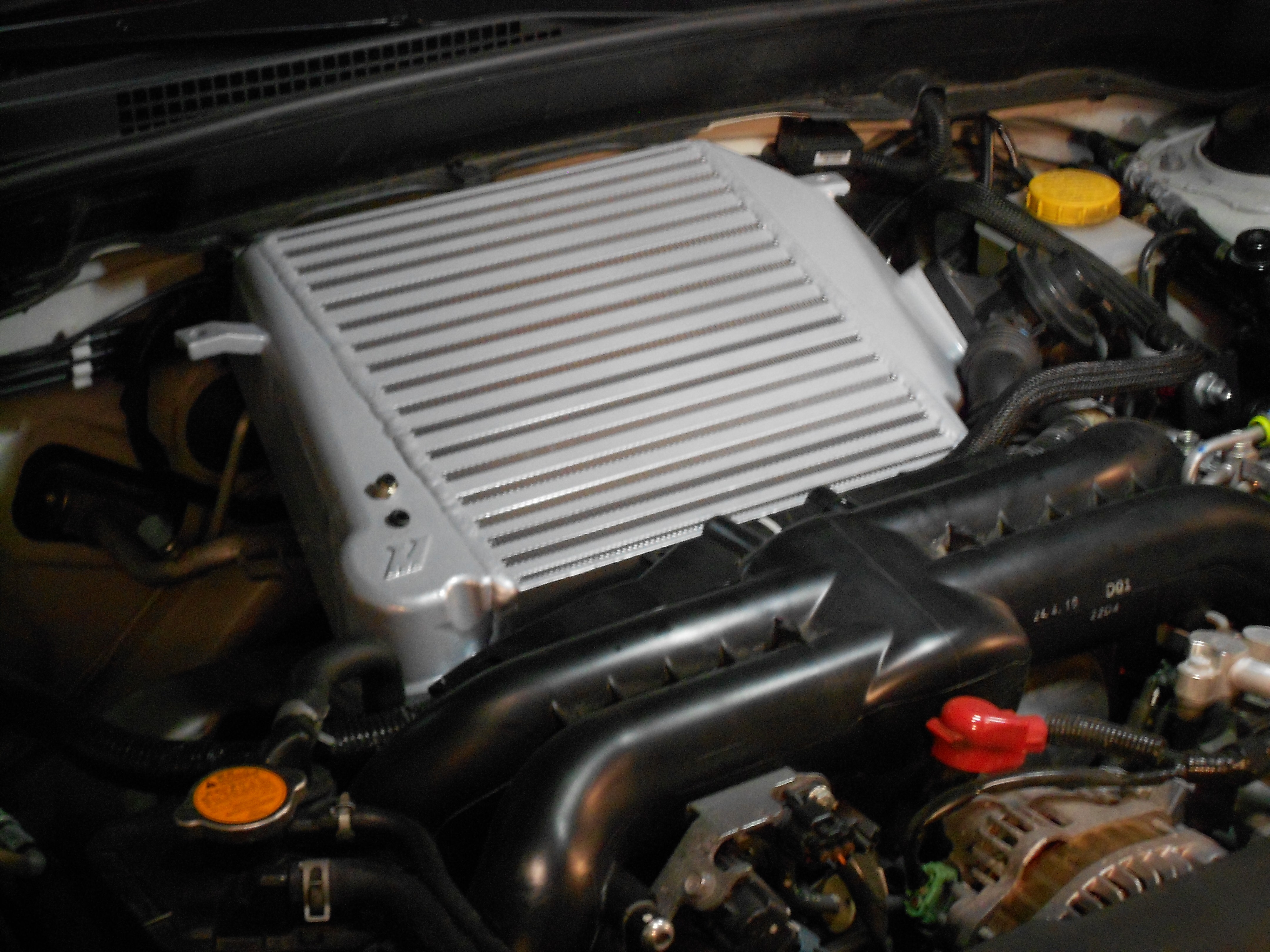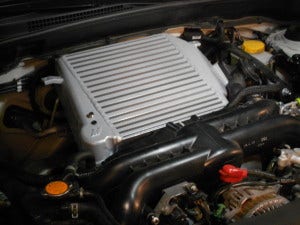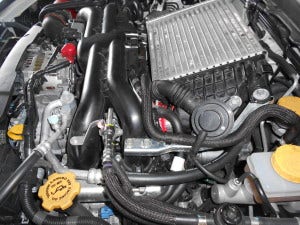
2008-2014 Subaru WRX Top-Mount Intercooler, Part 4: Data Presentation and Project Completion
Interested in purchasing our 2008-2014 Subaru WRX Top-Mount Intercooler? Check out more details on our product page linked below!
Mishimoto Subaru WRX Top-Mount Intercooler
Thanks for returning to the final portion of this build. Now that we have finished testing, it is time to review our data and see the improvements our cooler provided. To start things off, here is a shot of the cooler fully installed!

Mishimoto 2008-2014 WRX Intercooler installed
Let's dive into the data. First, we'll compare the basic specs of our cooler versus the OEM unit.

Internal flow area for Mishimoto vs stock intercooler
The Mishimoto intercooler features a 37.9% increase in internal flow area compared to the stock intercooler!

Core volume for Mishimoto vs stock intercooler
The Mishimoto intercooler features an 80% increase in internal core volume compared to the stock intercooler!

Total intercooler volume for Mishimoto vs stock intercooler
The Mishimoto intercooler features a 79.5% increase in overall intercooler volume compared to the stock intercooler!
Now that we have the physical specs covered, let's evaluate the data from our testing. For intercooler efficiency and AIT benefits, this data was collected during road pulls. We tested both the stock intercooler and the Mishimoto intercooler on a secluded road. The vehicle was driven from 3,000 rpm to 6,500 rpm in third gear. Each cooler was tested with three separate pulls, and these pulls were then averaged. To replicate consistent testing, we allowed the vehicle to cool for exactly five minutes after each run. The results are displayed in the graphs below!

Comparison of intercooler efficiency for Mishimoto vs stock

Comparison of outlet temperature for Mishimoto vs stock
These two graphs represent the big improvements you want to see with an intercooler upgrade. The Mishimoto intercooler was 10% more efficient at cooling AITs and was able to reduce outlet temperatures by 12°F on average. This is a great improvement on a nearly stock vehicle! Our engineers anticipate even greater improvements on a vehicle with higher boost, generating more heat.
Next up was our dynamometer results. Check out our plot below.

Comparison of power output temperature for Mishimoto vs stock intercooler
This testing was completed in a single day with little variation in ambient temperatures. The vehicle was strapped to the dyno and the intercoolers were swapped with the vehicle still on the dyno to ensure that none of the variables changed other than the intercooler itself. Each intercooler received a warm-up run and 4-5 additional runs until we had three consistent pulls to average. The fan shroud we fabricated provided the intercooler with 50 mph of airflow. The Mishimoto intercooler provided an average increase of 6 whp and 8 wtq compared to the stock intercooler. These are nice gains for a heat exchanger swap!
While we had the vehicle in the garage, we fitted it with our throttle body hose as well. Because the stock throttle body hose is quite prone to blowing out, we will be including our silicone replacement hose with this intercooler. We are assuming a majority of those upgrading their intercoolers are running higher boost pressures, so this is a great inclusion for some additional reliability.

Mishimoto silicone throttle body hose
So that essentially wraps up this project. Time to recap our goals and see how we did with meeting some of the tough requirements we set out to tackle.
Goals
- Must be completely direct-fit for the 2008-2014 Subaru WRX and also utilize the stock-style turbocharger flange connection.
The Mishimoto intercooler bolts into position just like the stock intercooler and functions perfectly with all stock equipment. No vehicle modification is necessary for installation.
- Support vehicles from stock power levels to 400 whp.
Our engineers recommend this cooler for vehicles from stock to 400 whp. We are setting a maximum rating of 500 whp, but we do recommend a front-mount intercooler setup for vehicles that achieve above 400 whp.
- Reduce efficiency and AITs compared to the stock intercooler.
Our data showed a 10% improvement in intercooler efficiency and an average of 12°F lower temperatures compared to the stock intercooler.
- Improve power output compared to the stock intercooler.
The Mishimoto intercooler provided 6 whp and 8 wtq average gains compared to the stock intercooler.
- Increase cooler volume to support higher power and heat.
The Mishimoto intercooler features an 80% increase in core volume compared to the stock intercooler.
So that rounds out our project! We were very successful on all fronts of our testing and development. We are very confident that this intercooler will provide the temperature reduction needed for your vehicle. Check out a shot of this cooler viewed from the scoop!

Mishimoto intercooler installed
Thanks for following along with the build! Feel free to follow up with any questions regarding the intercooler or our data!
Thanks




